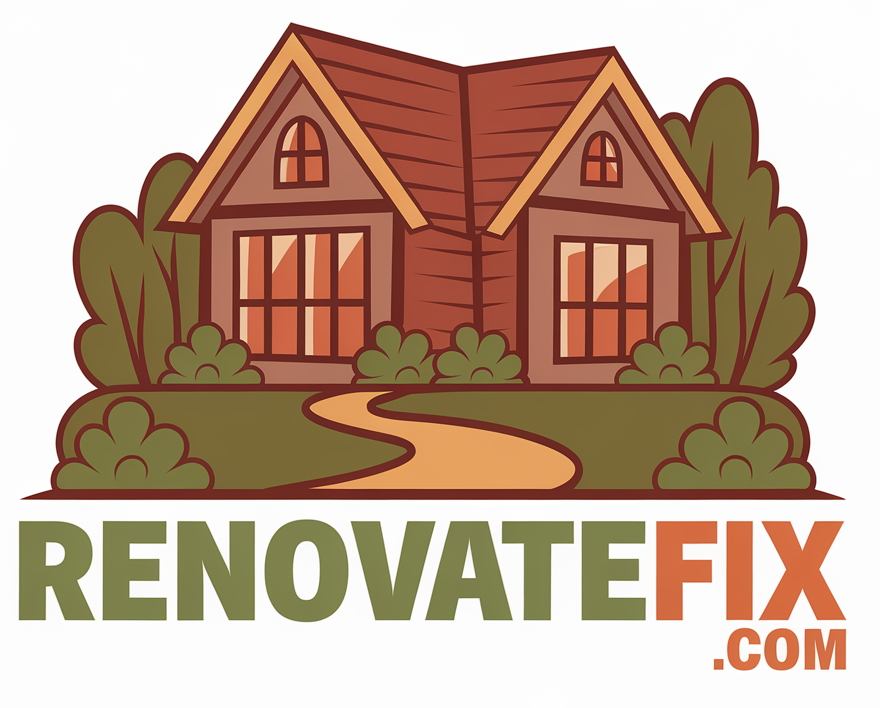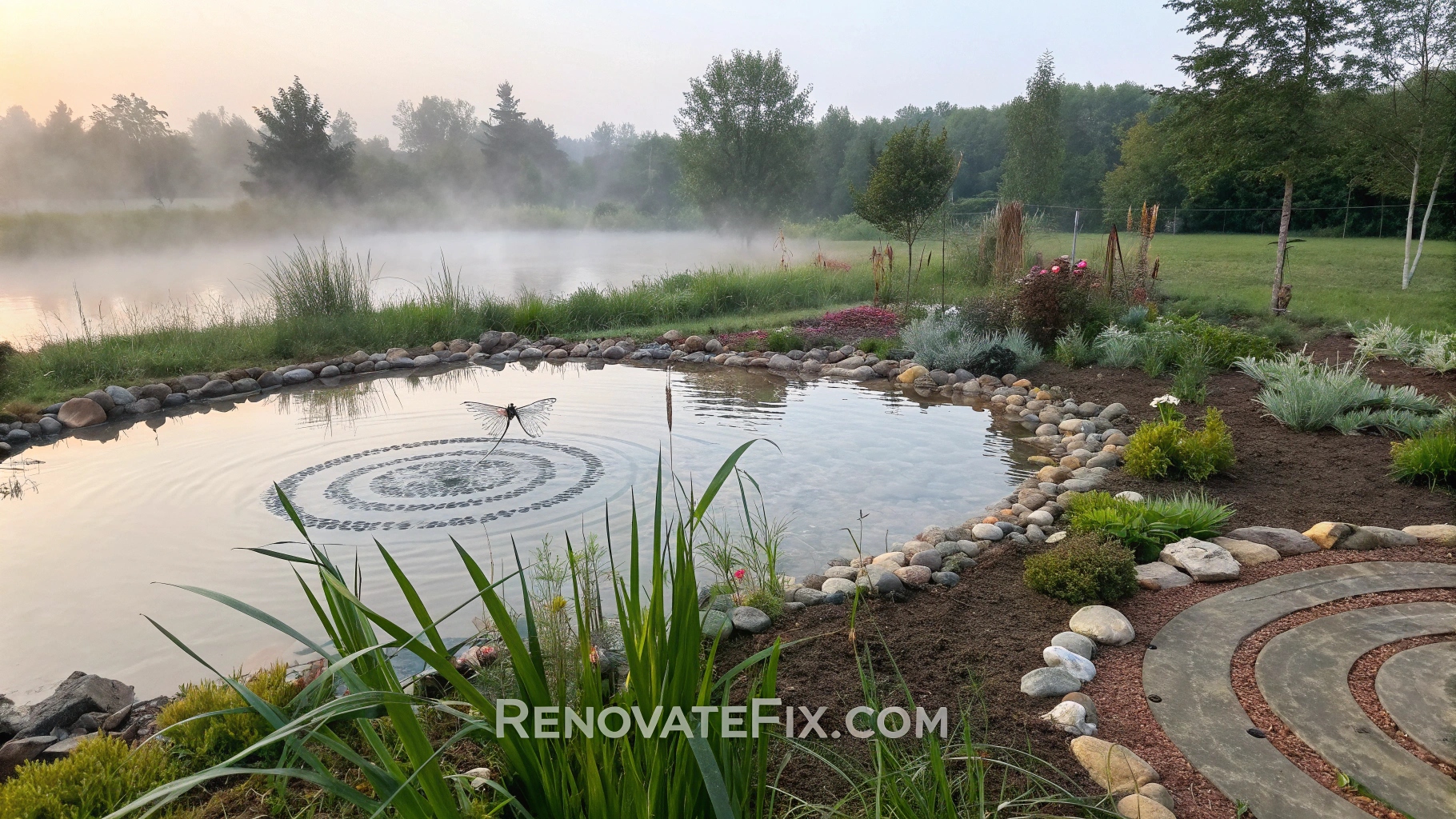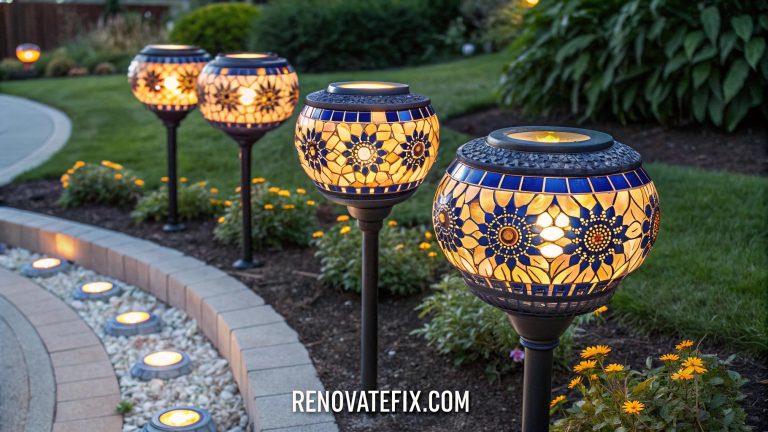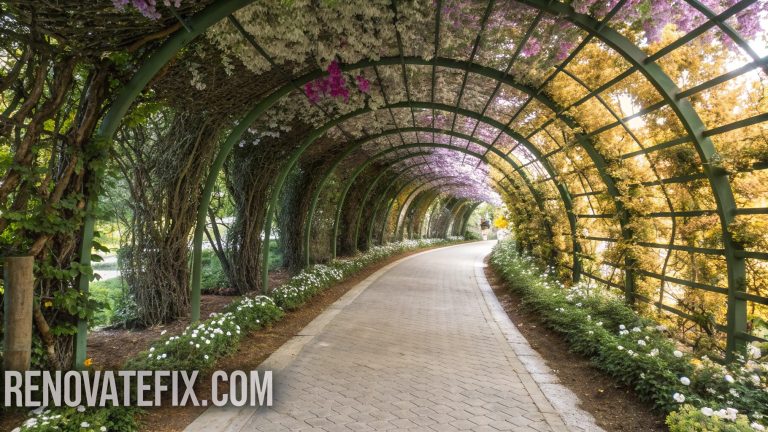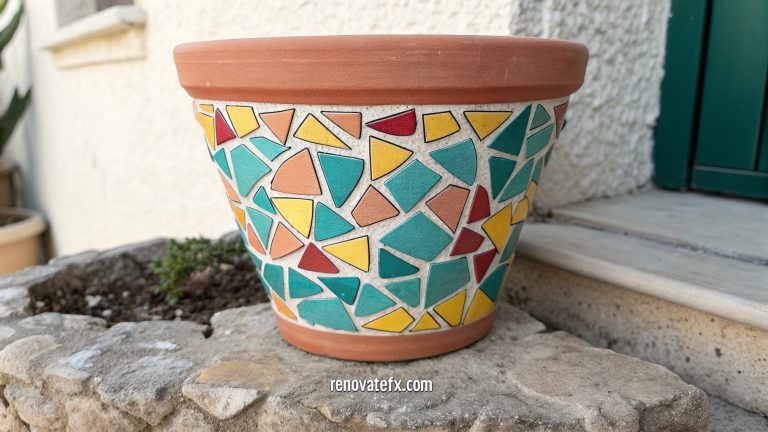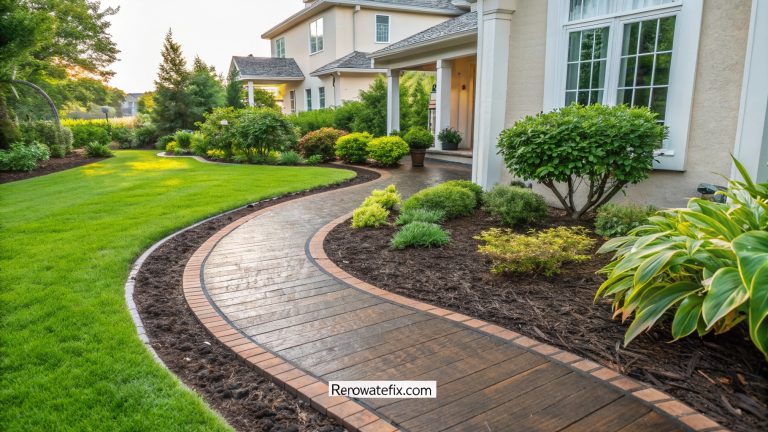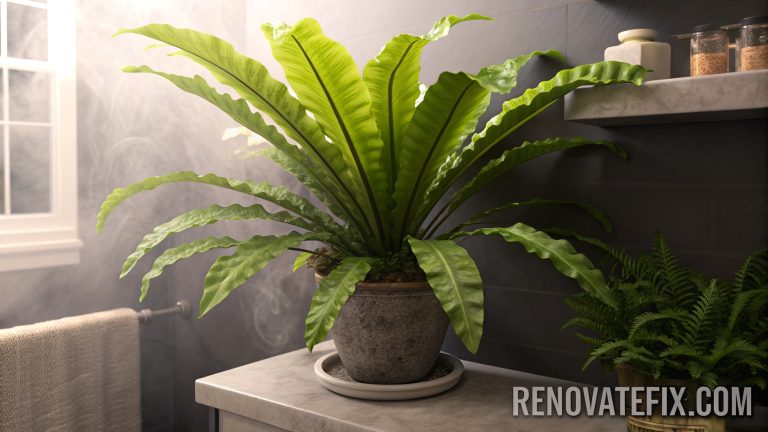20 Innovative Rainscaping Solutions for Eco-Friendly Yards
Water management represents a critical challenge as climate patterns shift worldwide.
Rainscaping offers homeowners and communities practical, attractive solutions for managing stormwater while creating vibrant ecosystems.
Unlike conventional landscaping, rainscaping works harmoniously with natural water cycles, reducing runoff, preventing erosion, and filtering pollutants.
This approach not only protects local waterways but also establishes resilient outdoor spaces that thrive during both drought and downpour conditions.
From simple modifications to comprehensive yard renovations, these twenty rainscaping ideas provide inspirational starting points for anyone looking to make their landscape more sustainable, functional, and beautiful.
1. Rain Gardens with Native Plants
Rain gardens function as shallow depressions strategically placed to collect runoff from roofs, driveways, and lawns.
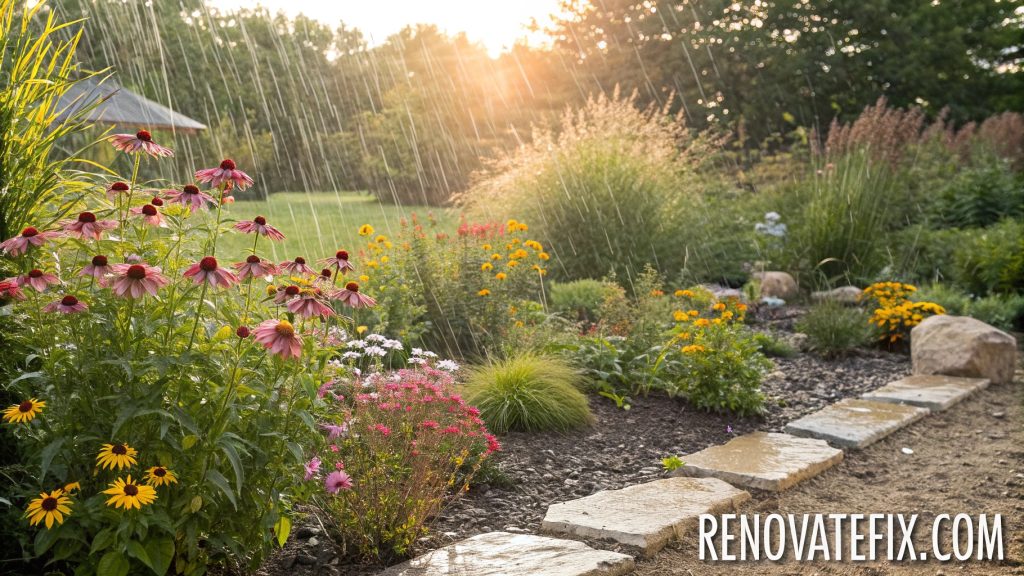
When filled with native wildflowers, grasses, and shrubs, these gardens absorb excess moisture through deep root systems while creating habitat for pollinators and birds.
Positioned at least ten feet from building foundations, properly constructed rain gardens drain completely within 24-48 hours, eliminating mosquito concerns while naturally filtering pollutants from stormwater before it reaches groundwater supplies.
2. Permeable Paving Systems
Permeable pavers allow water infiltration through specially designed surfaces rather than forcing runoff into storm drains.
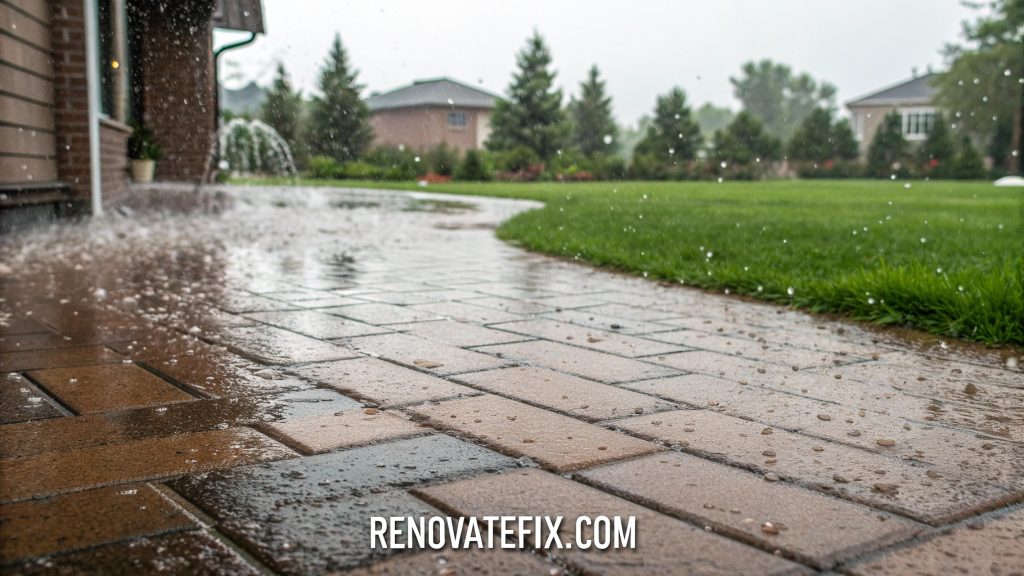
Made from porous concrete, brick arrangements with sand-filled joints, or plastic grid systems filled with gravel or grass, these surfaces maintain functionality while dramatically reducing flooding risks.
Perfect for driveways, patios, and walkways, permeable paving mimics natural processes by filtering water gradually into subsoil, replenishing aquifers beneath urban areas.
3. Vegetated Swales and Channels
Gently sloping channels lined with dense vegetation capture water from rainfall events, slowing its movement across landscapes.
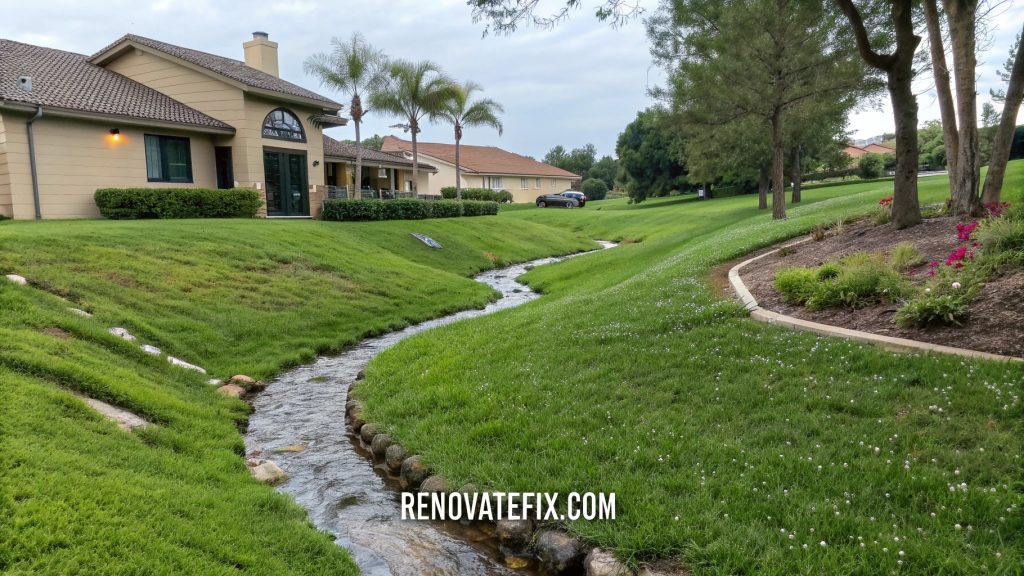
These engineered depressions guide stormwater away from structures while allowing gradual absorption into soil profiles.
Planted with flood-tolerant grasses, sedges, and rushes, vegetated swales filter sediment and contaminants naturally, preventing erosion during heavy precipitation while creating linear wildlife corridors throughout neighborhoods.
4. Green Roof Installations
Rooftop gardens covered with drought-resistant succulents, herbs, and grasses absorb up to 70% of rainfall that hits building surfaces.
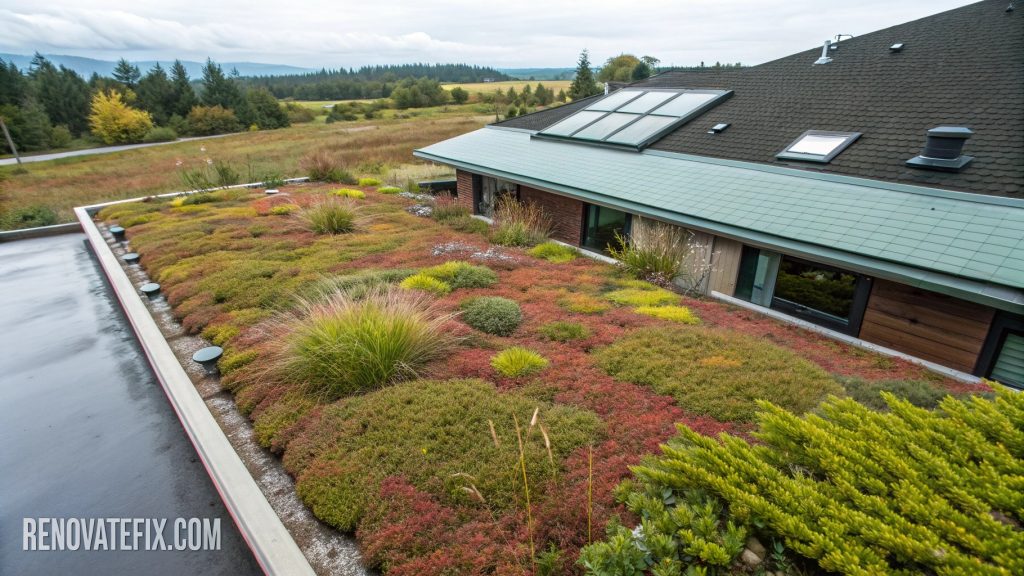
Beyond stormwater reduction, green roofs provide insulation, extend roof lifespans, reduce urban heat island effects, and create habitat oases in developed areas.
Modular systems make installation possible on structures ranging from garden sheds to commercial buildings, with lightweight growing media supporting plant communities specifically selected for rooftop survival.
5. Disconnected Downspouts
Redirecting roof drainage away from sewer systems represents one of simplest rainscaping modifications possible.
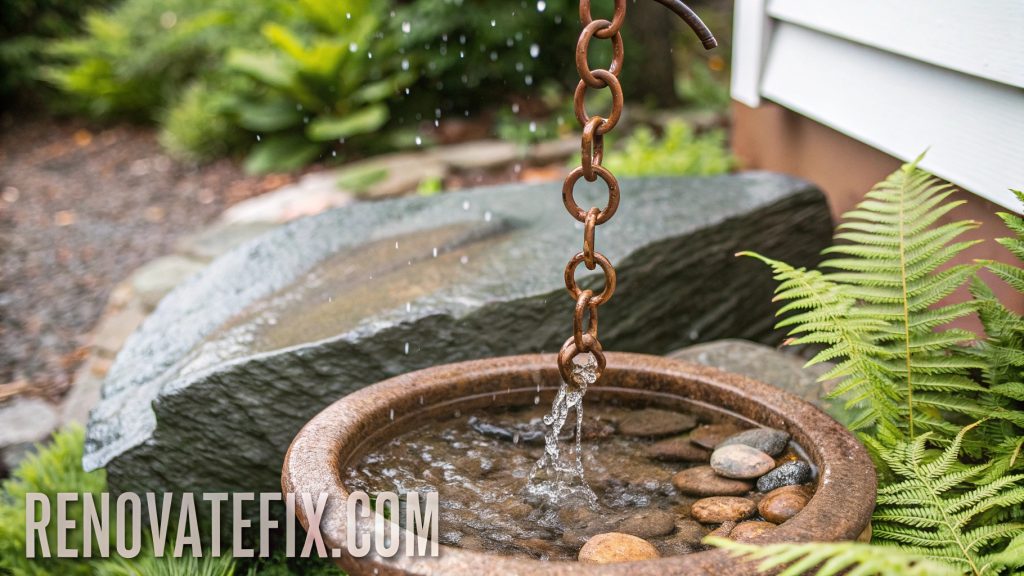
By removing direct connections between downspouts and storm drains, water flows instead toward vegetated areas designed for infiltration.
Simple extensions or decorative rain chains guide water toward rain gardens, dry creek beds, or lawn areas where it can naturally percolate into soil rather than contributing to municipal system overload.
6. Rainwater Harvesting Systems
Collection barrels, cisterns, and tanks capture valuable precipitation from roof surfaces for later use during dry periods.
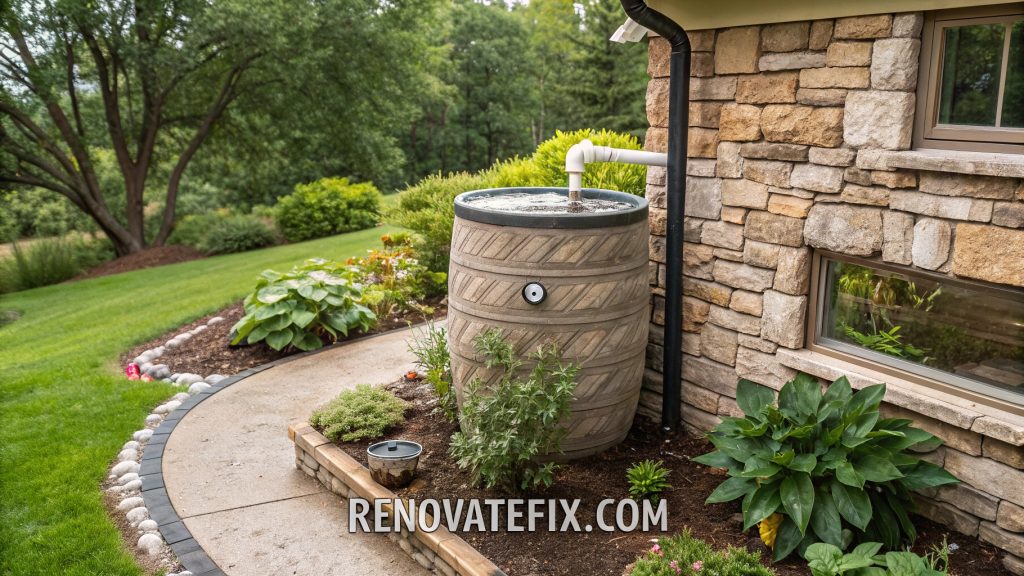
Connected to downspouts with overflow protection, these systems range from simple 50-gallon containers to underground storage units holding thousands of gallons.
Harvested rainwater, ideal for garden irrigation, reduces water bills while conserving municipal supplies. Decorative options seamlessly blend into landscapes, making utilitarian storage visually appealing.
7. Dry Creek Beds
Constructed channels lined with various sized stones mimic natural waterways while managing occasional water flow.
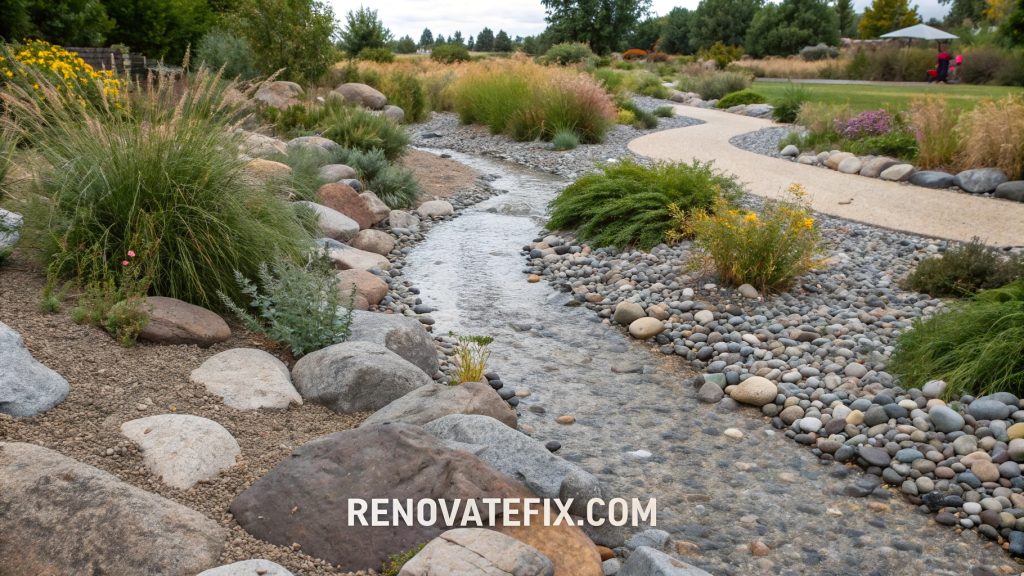
During rainfall, these attractive landscape features direct runoff away from structures and prevent erosion by slowing water movement.
During dry periods, they create visually interesting focal points winding through gardens.
Strategic placement of larger boulders and drought-resistant plants along edges enhances natural appearance while addressing practical drainage needs.
8. Bio-Retention Planters
Engineered containers filled with specialized soil media, mulch, and carefully selected plants filter and absorb runoff from adjacent impervious surfaces.
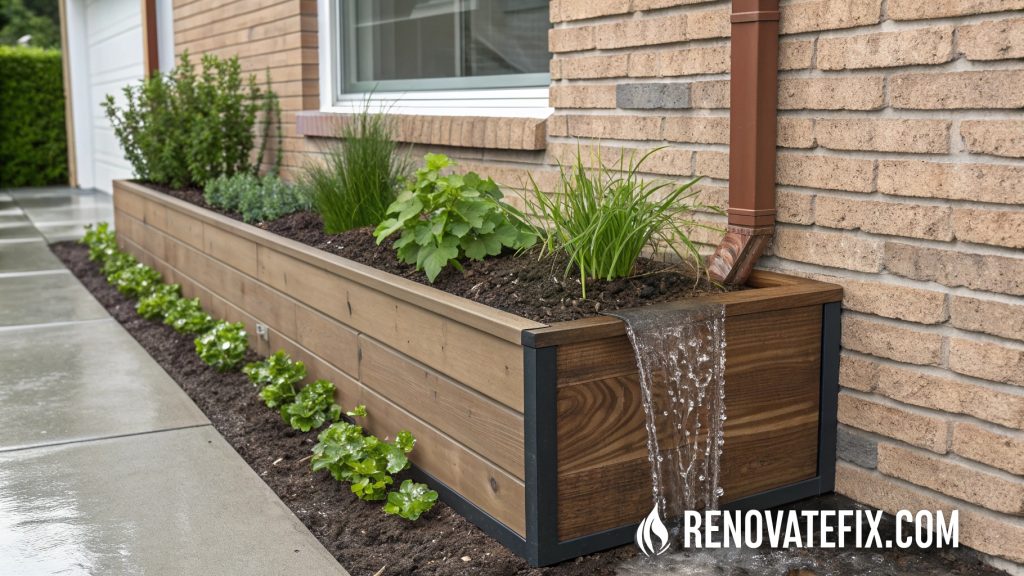
Often constructed as raised beds near buildings, these systems collect water from rooftops through modified downspouts.
Multiple layers of various materials – including sand, compost, and gravel – cleanse water naturally before excess moisture exits through bottom drainage systems, making these perfect solutions for urban environments with limited space.
9. Woodland Buffer Zones
Multi-layered plantings combining trees, shrubs, and ground covers create natural filtration systems along property edges, particularly effective where land slopes toward water bodies.

These mini-ecosystems slow runoff, filter pollutants, stabilize soil, and provide wildlife habitat simultaneously.
Mimicking forest floor conditions with leaf litter and organic matter increases absorption capacity during heavy rainfall events while reducing maintenance needs compared to traditional landscaping approaches.
10. Constructed Wetlands
Shallow depressions planted with water-loving species create functioning ecosystems that excel at water purification.
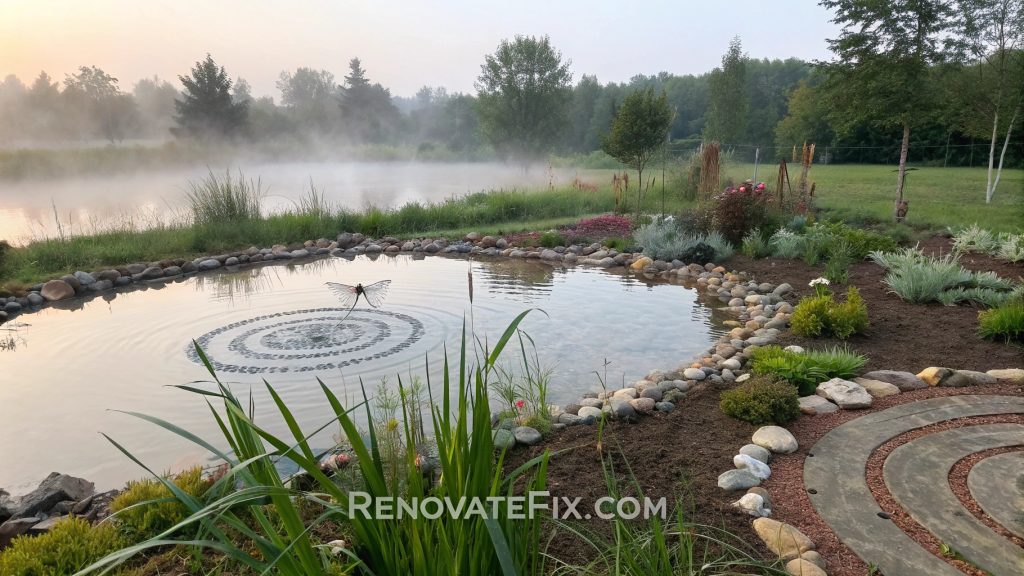
These engineered wetlands capture significant quantities of stormwater while supporting frogs, beneficial insects, and birds.
Standing water areas combined with saturated soil zones handle varying moisture levels throughout seasons.
Cattails, iris, and rush species provide visual interest while performing crucial ecological functions within planned landscape designs.
11. Minimal Mowing Zones
Designated areas left unmowed create natural filtration systems where rainfall infiltrates slowly through tall grasses and wildflowers.
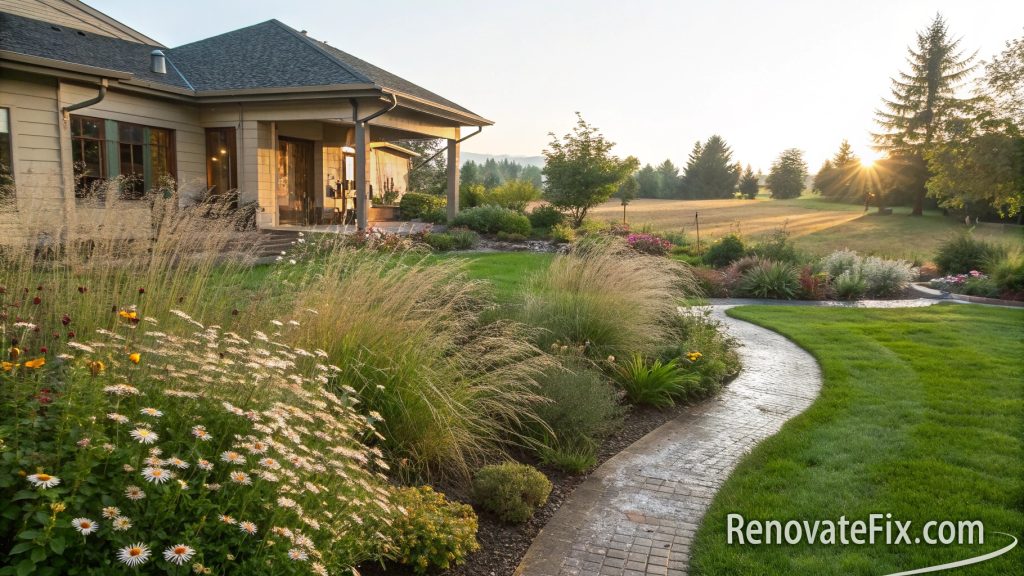
Converting portions of lawns to meadow-like conditions reduces maintenance while increasing biodiversity and absorption capacity.
These zones, particularly effective along property boundaries and in areas receiving significant runoff, develop deep root systems over time that create channels for water penetration deep into soil profiles.
12. Soil Amendments for Enhanced Absorption
Improving existing soil structure through organic matter additions dramatically increases water infiltration throughout landscapes.

Regular applications of compost, leaf mulch, and aged manure build carbon content while creating soil aggregates that maintain pore spaces even during heavy rainfall.
Enhanced microbial activity within amended soils accelerates water movement downward while improving nutrient availability for plants, creating win-win scenarios for both stormwater management and garden productivity.
13. Tree Well Retrofits
Existing trees gain enhanced rainfall capture capabilities through simple modifications to surrounding soil areas.
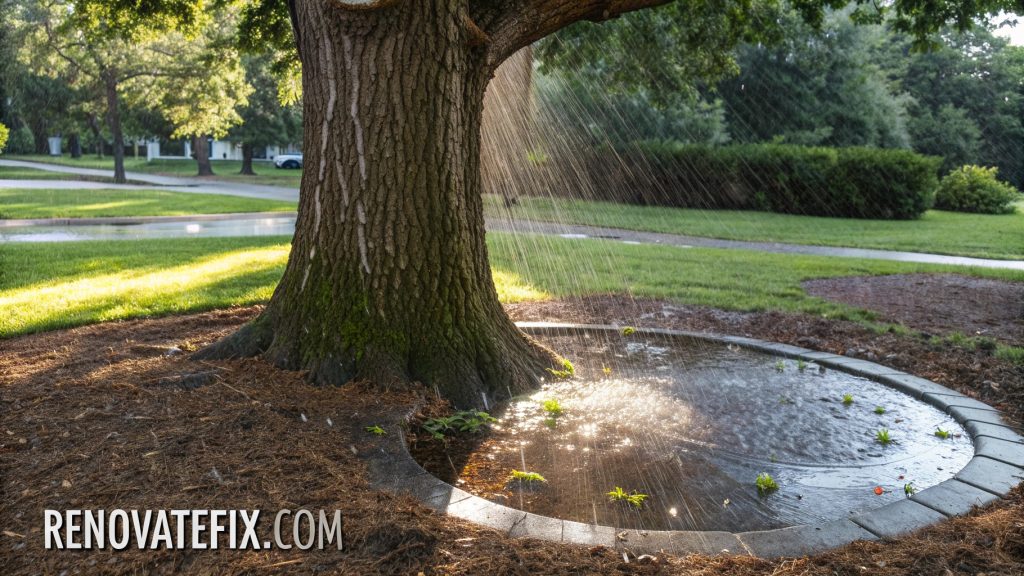
By creating slight depressions around trunks and adding mulch rings extending to drip lines, homeowners effectively create mini-collection basins that direct water toward root zones.
These subtle landscape adjustments prevent runoff while benefiting established trees, particularly when combined with understory plantings that add further absorption capacity beneath canopies.
14. Contour Farming for Sloped Landscapes
Planting along topographic lines rather than in straight rows dramatically reduces erosion on sloped properties.
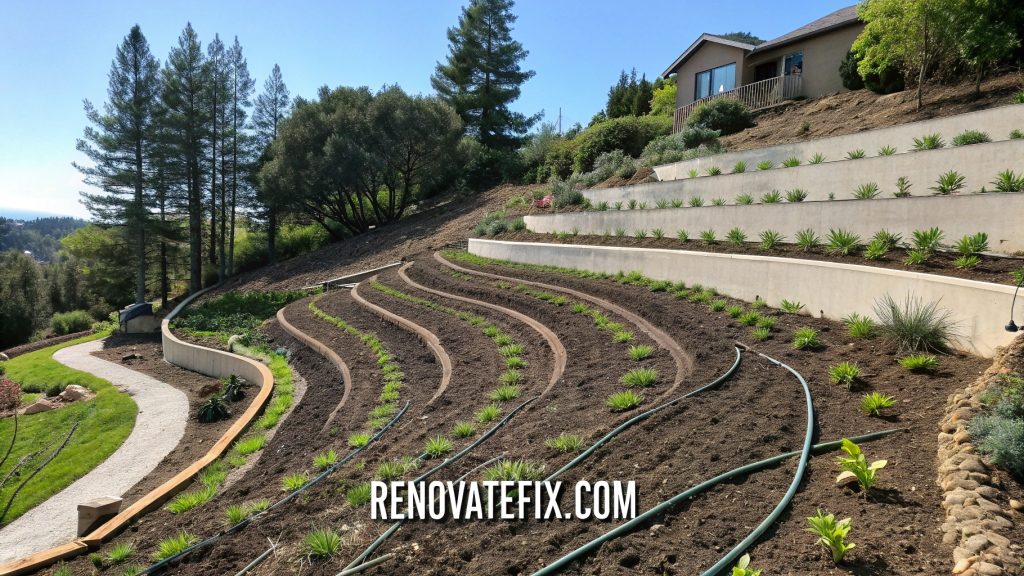
Whether applied to vegetable gardens, flower beds, or entire landscapes, contour arrangements slow water movement downhill, allowing greater infiltration opportunities.
Berms created along contours act as speed bumps for rainfall, holding moisture long enough for absorption rather than permitting rapid runoff that carries away valuable topsoil during storm events.
15. Rain Chains and Spillways
Decorative alternatives to closed downspouts create visual interest while managing roof runoff.
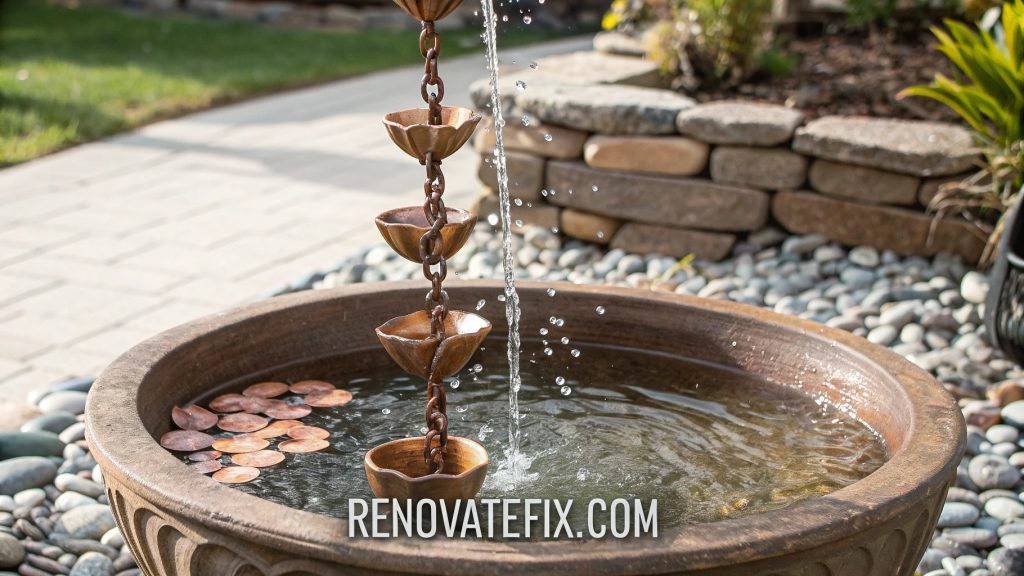
Copper chains, ceramic cups, or artistic metal sculptures guide water from gutters to collection areas below, turning drainage into water features.
The open design allows observation of water movement during rainfall while controlling flow rates to prevent erosion.
These architectural elements celebrate water rather than hiding it within conventional drainage systems.
16. Terraced Rain Gardens
Multiple small rain gardens connected by overflow channels create cascading systems perfect for managing water on sloped properties.
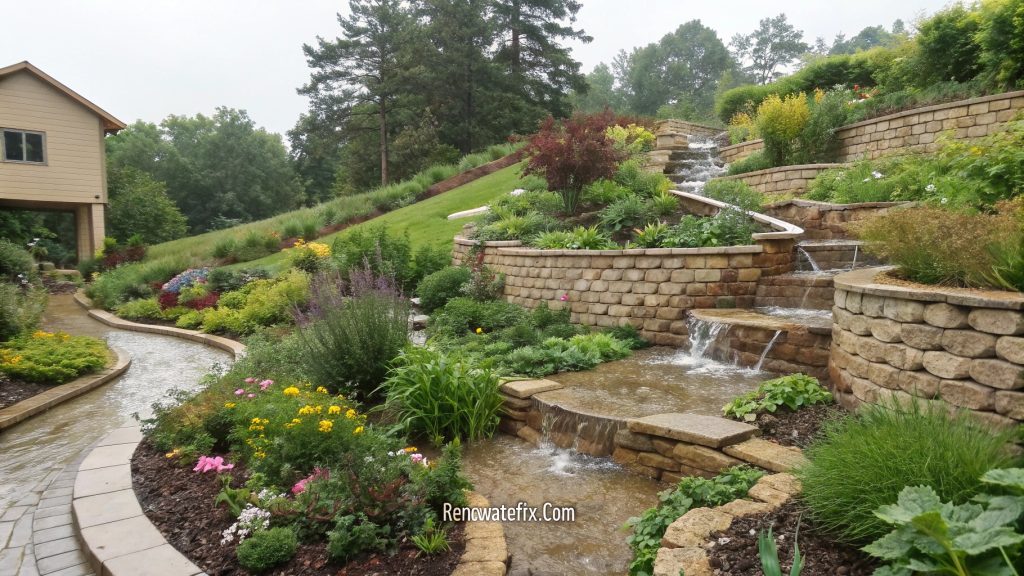
Each basin captures, holds, and infiltrates rainwater before excess flows to the next level.
Planted with species adapted to varying moisture conditions, these systems mimic natural stream dynamics while preventing erosion problems common on hillsides.
When dry, terraced gardens create visually attractive landscape elements featuring diverse plant communities.
17. Artistic Runoff Patterns
Deliberate surface designs direct water through landscapes in visually appealing ways.
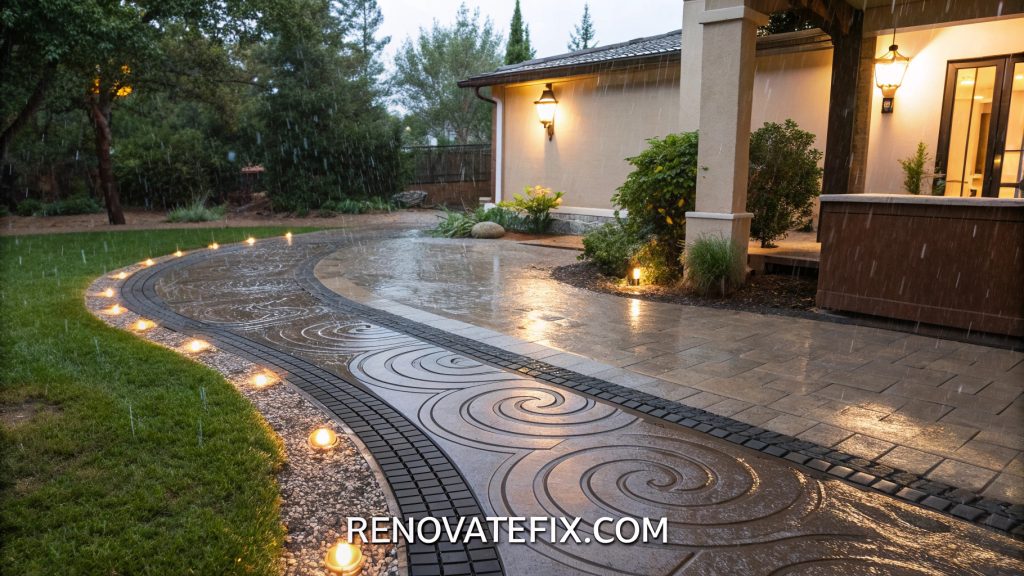
Cast concrete channels with decorative patterns, sculptural rock arrangements, or artistic metal guides create functional focal points while managing stormwater.
These hardscape elements guide runoff toward collection areas while adding artistic expression to practical water management.
When properly designed, these features appear as intentional artistic installations rather than utilitarian drainage solutions.
18. Naturalized Pond Edges
Retrofitting existing water features with graduated shelves and native plantings creates more effective stormwater management while enhancing habitat value.
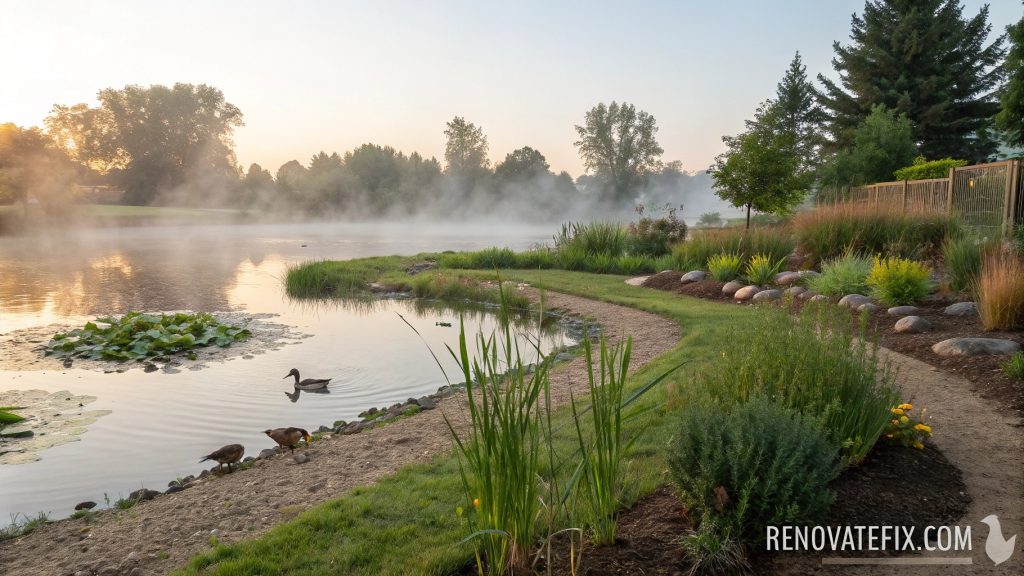
Unlike traditional ponds with abrupt edges, naturalized designs feature shallow transitions planted with emergent species that filter incoming water.
These planted margins protect against erosion during heavy rainfall while supporting amphibians, birds, and beneficial insects that require varying water depths throughout life cycles.
19. Mycorrhizal Networks
Introducing beneficial fungi through specialized soil amendments builds living water management systems below ground.
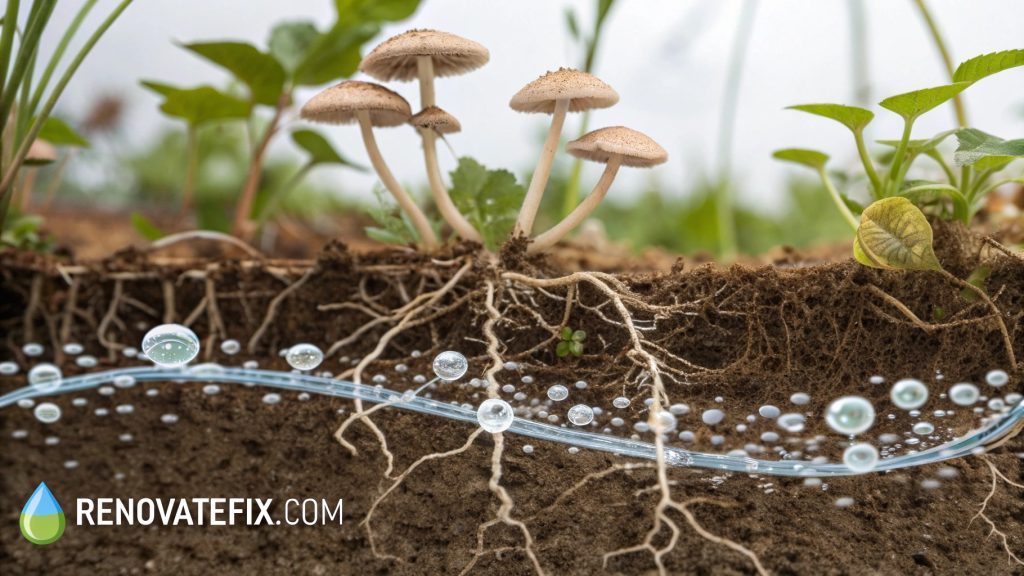
Mycorrhizal connections between plant roots and fungal networks dramatically increase absorption capabilities while improving plant health.
When established throughout landscapes, these microscopic partnerships create extensive underground highways for water movement, storing moisture during heavy rainfall and releasing it gradually during dry periods, effectively creating living water reservoirs.
20. Greywater Distribution Systems
Household water from sinks, showers, and washing machines gains second life through carefully designed distribution networks.
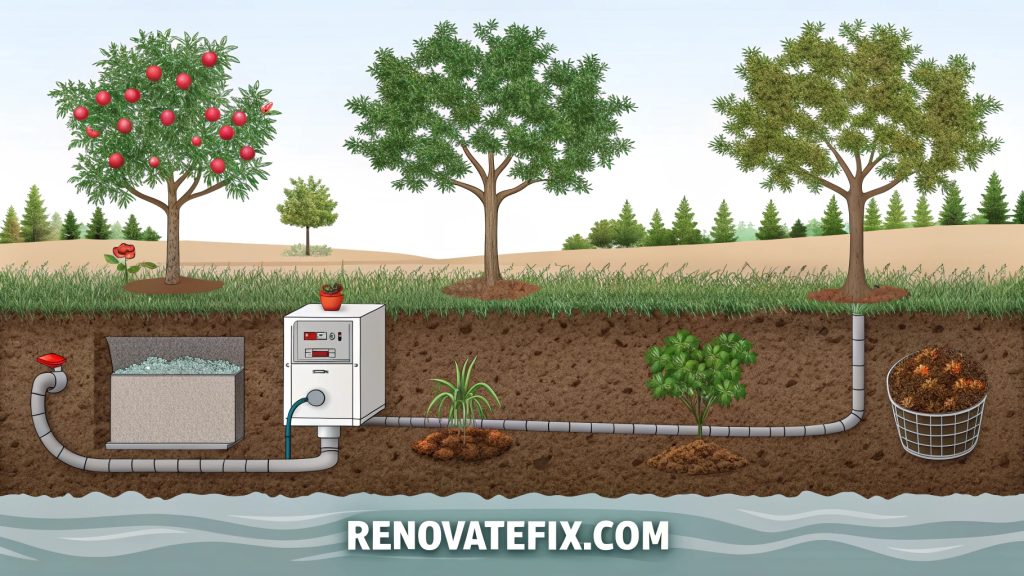
Rather than entering sewer systems, greywater irrigates specifically designed landscape areas through subsurface pipes or mulch-filled basins.
Appropriate plant selections thrive on nutrients present in greywater while natural soil processes filter and purify water before it reaches groundwater.
These systems reduce water consumption while creating drought-resistant landscape zones.
Conclusion
Rainscaping represents a fundamental shift in how we approach landscape design, moving from fighting against water to working alongside natural hydrological processes.
By implementing these innovative solutions, homeowners can dramatically reduce their environmental impact while creating more beautiful, functional outdoor spaces.
Each rainscaping feature contributes to watershed health, reduces flooding risks, and helps restore natural water cycles disrupted by development.
As climate patterns continue changing, these rainscaping approaches provide resilience against both drought and deluge conditions.
Start with one simple modification, then gradually expand your rainscaping efforts – every drop captured and properly managed represents progress toward more sustainable communities and healthier ecosystems for generations to come.
